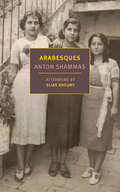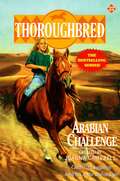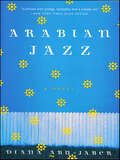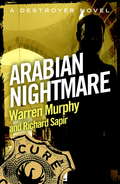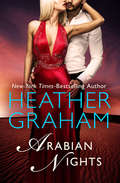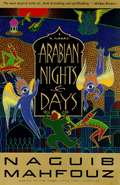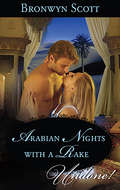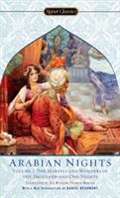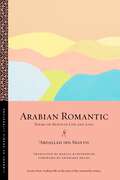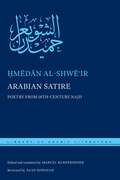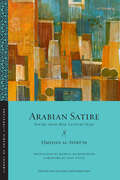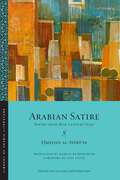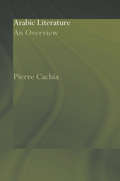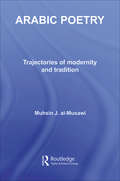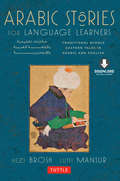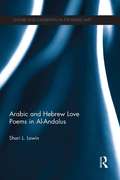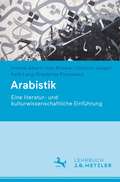- Table View
- List View
Arabesques
by Anton ShammasA luminous, inventive, and deeply personal exploration of living in the liminal space between Jewish and Arab, ancient and modern, by a gifted Palestinian writer.Chosen by The New York Times as one of the best books of 1988, Arabesques is a luminous novel that engages with history and politics not as propaganda but as literature. That engagement begins with the language in which the book is written: Anton Shammas, from a Palestinian Christian family and raised in Israel, wrote in Hebrew, as no Arab novelist had before. The choice was provocative to both Arab and Jewish readers.Arabesques is divided into two sections: &“The Tale&” and &“The Teller.&” &“The Tale&” tells of several generations of family life in a rural village, of the interplay of past and present, of how memory intersects with history in a part of the world where different people have both lived together and struggled against each other for centuries. &“The Teller&” is about the writer&’s voyage out of that world to Paris and the United States, as he comes into his vocation as a writer, and raises questions about the authority of the storyteller and the nature of the self. Shammas&’s tour de force is both a personal and a political narrative—a reinvention of the novel as a way of envisioning and responding to historical and cultural legacies and conflicts.
Arabian Challenge (Thoroughbred #22)
by Joanna CampbellFor as long as she can remember, Cindy Blake has longed to ride a Thoroughbred in a world-class race. And now that she's 16, Cindy's dream is finally coming true. She'll ride Wonder's Champion, the Triple Crown winner, in Arabia's Dubai Cup! Cindy's competition is tough. She'll be racing against the best horses and jockeys in the world--including her friend and teacher, Ashleigh Griffen!
Arabian Jazz: A Novel
by Diana Abu-Jaber"This oracular first novel, which unfurls like gossamer [has] characters of a depth seldom found in a debut." —The New YorkerIn Diana Abu-Jaber's "impressive, entertaining" (Chicago Tribune) first novel, a small, poor-white community in upstate New York becomes home to the transplanted Jordanian family of Matussem Ramoud: his grown daughters, Jemorah and Melvina; his sister Fatima; and her husband, Zaeed. The widower Matuseem loves American jazz, kitschy lawn ornaments, and, of course, his daughters. Fatima is obsessed with seeing her nieces married—Jemorah is nearly thirty! Supernurse Melvina is firmly committed to her work, but Jemorah is ambivalent about her identity and role. Is she Arab? Is she American? Should she marry and, if so, whom?Winner of the Oregon Book Award and finalist for the National PEN/Hemingway Award, Arabian Jazz is "a joy to read…You will be tempted to read passages out loud. And you should" (Boston Globe). USA Today praises Abu-Jaber's "gift for dialogue...her Arab-American rings musically, and hilariously, true."
Arabian Nightmare: Number 86 in Series (The Destroyer #86)
by Warren Murphy Richard SapirRemo and Chiun face a diabolical dictator and a female fiend in a middle eastern hell.
Arabian Nights
by Heather GrahamAn Egyptologist teams up with an arrogant but gorgeous reporter to find her missing father in this romance from the New York Times–bestselling author. Days before starting a history-making excavation in a remote sector of the Valley of the Kings, Dr. Alexandria Randall&’s father, a fellow Egyptologist, goes missing. Alex will stop at nothing to find her father—a gargantuan task in an ancient land where she doesn&’t make the rules—even if she&’s also a target. Alex must swallow her pride and ask for protection from an arrogant journalist named Dan. To find her father, Alex must play Dan&’s wife—a ruse that both find insufferable. But with her father&’s life hanging in the balance, Alex is determined to make their mock marriage work. This ebook features an illustrated biography of Heather Graham including rare photos from the author&’s personal collection.
Arabian Nights Illustrated: Art of Dulac, Folkard, Parrish and Others
by Jeff A. MengesAccording to legend, a resourceful bride won a stay of execution by captivating a sultan with a series of fantastic tales--and after 1,001 nights, the sultan could not bear to part with his storyteller. More than a thousand years later, readers continue to fall under the spell of the romantic adventures known as the Arabian Nights. This original collection features rare and unusual illustrations inspired by the traditional tales of Sinbad, Aladdin, Ali Baba, and a host of other exotic characters.Spanning the decades between the 1890s and the 1920s, this volume draws upon images from the Golden Age of Illustration, when technological advances in printing led to a boom in the publication of artwork. Drawings and paintings by Maxfield Parrish, Edmund Dulac, Charles Folkard, and other acclaimed artists of the era appear here, in more than 185 color and black-and-white illustrations with captions. Abounding in mystery and excitement, these scenes from the timeless tales of heroism will captivate all lovers of fantasy and fairy tales, as well as collectors of rare books and art and illustration enthusiasts.
Arabian Nights Kathalu
by C.V.S. RajuArabian Nights is a set of 15 Telugu stories picked from the famous Arabian Night stories which is a set of Middle Eastern and South Asian folk stories.
Arabian Nights and Days
by Naguib MahfouzA renowned Nobel Prize-winning novelist refashions the classic tales of Scheherazade in his own imaginative, spellbinding style. Here are genies and flying carpets, Aladdin and Sinbad, Ali Baba, and many other familiar stories, made new by the magical pen of the acknowledged dean of Arabic letters.
Arabian Nights and Days: A Novel
by Naguib Mahfouz Denys Johnson-DaviesA renowned Nobel Prize-winning novelist refashions the classic tales of Scheherazade in his own imaginative, spellbinding style. Here are genies and flying carpets, Aladdin and Sinbad, Ali Baba, and many other familiar stories, made new by the magical pen of the acknowledged dean of Arabic letters.
Arabian Nights with a Rake
by Bronwyn ScottAlgerian Desert, 1833Held captive in a Bedouin camp, Susannah Sutcliffe was bid to dress in scandalous silks and dance for the sheikh's guests. The request wasn't new to Susannah--but the presence of English diplomat Alex Grayfield was a shock she had not anticipated! Handsome and charming, Alex exuded a powerful masculinity that Susannah found irresistible...and he was unmistakably aroused by her sensual dance. Soon, Susannah had a plan to escape her desert captors: convince Alex to rescue her--by seducing him....
Arabian Nights: The Marvels and Wonders of the Thousand and One Nights
by Sir Richard Francis Burton Jack ZipesAfter King Shahryar had his wife killed for cheating, he began to corrupt--then kill--one virgin a night, as revenge on womankind. Then he meets Scheherazade, who, night after night, saves her own life by telling him fantastical tales of genies, wishes, terror, and passion. Famous stories from here are Aladdin and His Magic Lamp, Ali Baba and the Forty Thieves, and others. Frequent telling of sexual activities through analogy. There is a glossary at the end, which would be helpful to read before beginning. The original (supposedly) 30 volumes were later whittled down to 10 volumes, and now to one volume of the major stories and other of lesser stories.
Arabian Romantic: Poems on Bedouin Life and Love (Library of Arabic Literature #33)
by ʿAbdallāh ibn SbayyilLove poems from late nineteenth-century Arabia Arabian Romantic captures what it was like to live in central Arabia before the imposition of austere norms by the Wahhabi authorities in the early twentieth century: tales of robbery and hot pursuit; perilous desert crossings; scenes of exhaustion and chaos when water is raised from deep wells under harsh conditions; the distress of wounded and worn-out animals on the brink of perdition; once proud warriors who are at the mercy of their enemy on the field of battle. Such images lend poignancy to the suffering of the poet’s love-stricken heart, while also painting a vivid portrait of typical Bedouin life. Ibn Sbayyil (ca. 1853–1933), a town dweller from the Najd region of the Arabian Peninsula, was a key figure in the Nabati poetic tradition. His poetry, which is still recited today, broke with the artifice of the preceding generation by combining inherited idiom and original touches reflecting his environment. Translated into English for the first time by Marcel Kurpershoek, Arabian Romantic will delight readers with a poetry that is direct, fluent, and expressive, and that has entertained Arabic speakers for over a century.A bilingual Arabic-English edition.
Arabian Romantic: Poems on Bedouin Life and Love (Library of Arabic Literature #69)
by ʿAbdallāh ibn SbayyilScenes from Arabian life at the turn of the twentieth centuryArabian Romantic captures what it was like to live in central Arabia before the imposition of austere norms by the Wahhabi authorities in the early twentieth century: tales of robbery and hot pursuit; perilous desert crossings; scenes of exhaustion and chaos when water is raised from deep wells under harsh conditions; the distress of wounded and worn-out animals on the brink of perdition; once proud warriors who are at the mercy of their enemy on the field of battle. Such images lend poignancy to the suffering of the poet’s love-stricken heart, while also painting a vivid portrait of typical Bedouin life.Ibn Sbayyil, a town dweller from the Najd region of the Arabian Peninsula, was a key figure in the Nabaṭī poetic tradition. His poetry, which is still recited today, broke with the artifice of the preceding generation by combining inherited idiom and original touches reflecting his environment. Translated into English for the first time by Marcel Kurpershoek, Arabian Romantic will delight readers with a poetry that is direct, fluent, and expressive, and that has entertained Arabic speakers for over a century.An English-only edition.
Arabian Satire: Poetry from 18th-Century Najd (Library of Arabic Literature #49)
by Ḥmēdān al-ShwēʿirThis lively volume collects poems by Hmedan al-Shwe'ir, who lived in Najd in the Arabian Peninsula shortly before the hegemony of the Wahhabi movement in the early eighteenth century.A master of satire known for his ribald humor, self-deprecation, and invective verse (hija'), Hmedan was acerbic in his criticisms of society and its morals, voiced in in a poetic idiom that is widely referred to as “Nabati,” here a mix of Najdi vernacular and archaic vocabulary and images dating back to the origins of Arabic poetry. In Arabian Satire, Hmedan is mostly concerned with worldly matters, and addresses these in different guises: as the patriarch at the helm of the family boat and its unruly crew; as a picaresque anti-hero who revels in taking potshots at the established order, its hypocrisy, and its moral failings; as a peasant who labors over his palm trees, often to no avail and with no guarantee of success; and as a poet recording in verse how he thinks things ought to be.The poems in Arabian Satire reveal a plucky, headstrong, yet intensely socially committed figure—representative of the traditional Najdi ethos—who infuses his verse with proverbs, maxims, and words of wisdom expressed plainly and conversationally. Hmedan is accordingly quoted by historians of the Gulf region and in anthologies of popular sayings. This is the first full translation of this remarkable poet. A bilingual Arabic-English edition.
Arabian Satire: Poetry from 18th-Century Najd (Library of Arabic Literature #62)
by Ḥmēdān Al-ShwēʿirSatirical verse on society and its hypocrisiesA master of satire known for his ribald humor, self-deprecation, and invective verse (hijāʾ), the poet Ḥmēdān al-Shwēʿir was an acerbic critic of his society and its morals. Living in the Najd region of the Arabian Peninsula, Ḥmēdān wrote in an idiom widely referred to as “Nabaṭī,” here a mix of Najdī vernacular and archaic vocabulary and images dating to the origins of Arabic poetry. In Arabian Satire, Ḥmēdān is mostly concerned with worldly matters and addresses these in different guises: as the patriarch at the helm of the family boat and its unruly crew; as a picaresque anti-hero who revels in taking potshots at the established order, its hypocrisy, and its failings; as a peasant who labors over his palm trees, often to no avail and with no guarantee of success; and as a poet recording in verse how he thinks things ought to be.The poems in Arabian Satire reveal a plucky, headstrong, yet intensely socially committed figure—representative of the traditional Najdī ethos—who infuses his verse with proverbs, maxims, and words of wisdom expressed plainly and conversationally. Ḥmēdān is widely quoted by historians of the Gulf region and in anthologies of popular sayings. This is the first full translation of this remarkable poet.An English-only edition.
Arabian Satire: Poetry from 18th-Century Najd (Library of Arabic Literature #62)
by Ḥmēdān al-ShwēʿirSatirical verse on society and its hypocrisiesA master of satire known for his ribald humor, self-deprecation, and invective verse (hijāʾ), the poet Ḥmēdān al-Shwēʿir was an acerbic critic of his society and its morals. Living in the Najd region of the Arabian Peninsula, Ḥmēdān wrote in an idiom widely referred to as “Nabaṭī,” here a mix of Najdī vernacular and archaic vocabulary and images dating to the origins of Arabic poetry. In Arabian Satire, Ḥmēdān is mostly concerned with worldly matters and addresses these in different guises: as the patriarch at the helm of the family boat and its unruly crew; as a picaresque anti-hero who revels in taking potshots at the established order, its hypocrisy, and its failings; as a peasant who labors over his palm trees, often to no avail and with no guarantee of success; and as a poet recording in verse how he thinks things ought to be.The poems in Arabian Satire reveal a plucky, headstrong, yet intensely socially committed figure—representative of the traditional Najdī ethos—who infuses his verse with proverbs, maxims, and words of wisdom expressed plainly and conversationally. Ḥmēdān is widely quoted by historians of the Gulf region and in anthologies of popular sayings. This is the first full translation of this remarkable poet.An English-only edition.
Arabic As A Secret Song (CARAF Books: Caribbean and African Literature Translated from French)
by Skyler ArtesThe celebrated and highly versatile writer Leïla Sebbar was born in French colonial Algeria but has lived nearly her entire adult life in France, where she is recognized as a major voice on the penetrating effects of colonialism in contemporary society. The dramatic contrast between her past and present is the subject of the nine autobiographical essays collected in this volume. Written between 1978 and 2006, they trace a journey that began in Aflou, Algeria, where her father ran a schoolhouse, and continued to France, where Sebbar traveled, alone, as a graduate student before eventually realizing her powerful creative vision. The pieces collected in this book capture an array of experiences, sensations, and sentiments surrounding the French colonial presence in Algeria and offer an intimate and prismatic reflection on Sebbar’s bicultural upbringing as the child of an Algerian father and French mother. Sebbar paints an unflinching portrait of her original disconnection from her father’s Arabic language and culture, depicting her struggle to revive a cultural heritage that her family had deliberately obscured and to convey the vibrant yet muted Arabic of her father and of Algeria. Looking back from numerous vantage points throughout her life, she presents the complicated and divisive dynamics of being raised "between two shores"--the colonized and the colonizer. CARAF Books: Caribbean and African Literature Translated from French
Arabic Literature for the Classroom: Teaching Methods, Theories, Themes and Texts
by Mushin J al-MusawiArabic Literature for the Classroom argues for a more visible presence of Arabic within the humanities and social sciences, stressing the need to make Arabic literature available as a world literature, without damaging its own distinctive characteristics. The nineteen chapters which make up this book broach theoretical and methodical cultural concerns in teaching literatures from non-American cultures, along with issues of cross-cultural communication, cultural competency and translation. While some chapters bring out the fascinating and ever tantalizing connections between Arabic and the literatures of medieval Europe, others employ specific approaches to teaching particular texts, potential methodologies, themes and a variety of topics that can place Arabic widely in a vast swathe of academic application and learning. Topics that are explored include gender, race, class, trauma, exile, dislocation, love, rape, humor, and cinema, as well as issues that relate to writers and poets, women’s writing and the so called nahdah (revival) movement in the 19th Century. The comparative framework and multi-disciplinary approach means that this book injects new life into the field of Arabic Literature. It will therefore be an essential resource for students, scholars and teachers of Arabic Literature, as well as for anyone with an interest in learning more about Arabic culture.
Arabic Literature in the Post-Classical Period
by Roger Allen D. S. RichardsThe final volume of The Cambridge History of Arabic Literature explores the Arabic literary heritage of the little-known period from the twelfth to the beginning of the nineteenth century. Even though it was during this time that the famous Thousand and One Nights was composed, very little has been written on the literature of the period generally. In this volume Roger Allen and Donald Richards bring together some of the most distinguished scholars in the field to rectify the situation. The volume is divided into parts with the traditions of poetry and prose covered separately within both their 'elite' and 'popular' contexts. The last two sections are devoted to drama and the indigenous tradition of literary criticism. As the only work of its kind in English covering the post-classical period, this book promises to be a unique resource for students and scholars of Arabic literature for many years to come.
Arabic Literature to the end of the Umayyad Period
by T. M. Johnstone R. B. Serjeant A. F. L. Beeston G. R. SmithOriginally published in 1983, The Cambridge History of Arabic Literature was the first general survey of the field to have been published in English for over fifty years and the first attempted in such detail in a multi-volume form. The volumes of the History provide an invaluable source of reference and understanding of the intellectual, literary and religious heritage of the Arabic-speaking and Islamic world. This volume begins its coverage with the oral verse of the sixth century AD, and ends with the fall of the Umayyad dynasty two centuries later. Within this period fall major events: the life of the Prophet Muhammad, the founding of the Islamic religion, the great Arab Islamic conquests of territories outside the Arabian Peninsula, and their meeting, as overlords, with the Byzantine and Sasanian world. Contributors to this volume discuss an array of topics including the influences of Greeks, Persians and Syrians on early Arabic literature.
Arabic Literature: An Overview (Culture and Civilization in the Middle East)
by Pierre CachiaAssuming no previous knowledge of the subject, Arabic Literature - An Overview gives a rounded and balanced view of Arab literary creativity. 'High' literature is examined alongside popular folk literature, and the classical and modern periods, usually treated separately, are presented together. Cachia's observations are not subordinated to any pre-formed literary theory, but describe and illustrate the directions taken, in order to present an overall picture of the field of relevance to the student of literature as well as to Arabists working in related fields.
Arabic Poetry: Trajectories of Modernity and Tradition (Routledge Studies in Middle Eastern Literatures)
by Muhsin J. al-MusawiSince the late 1940s, Arabic poetry has spoken for an Arab conscience, as much as it has debated positions and ideologies, nationally and worldwide. This book tackles issues of modernity and tradition in Arabic poetry as manifested in poetic texts and criticism by poets as participants in transformation and change. It studies the poetic in its complexity, relating to issues of selfhood, individuality, community, religion, ideology, nation, class and gender. Al-Musawi also explores in context issues that have been cursorily noticed or neglected, like Shi’i poetics, Sufism, women’s poetry, and expressions of exilic consciousness. Arabic Poetry employs current literary theory and provides comprehensive coverage of modern and post-modern poetry from the 1950s onwards, making it essential reading for those with interests in Arabic culture and literature and Middle East studies.
Arabic Stories
by Hezi Brosh Lutfi MansurArabic Stories for Language Learners—a language learning experience for beginner to intermediate students. The traditional stories of a country are invaluable at providing insight into understanding the culture, history and language of a people. The sixty-six stories found in Arabic Stories for Language Learners present the vocabulary and grammar used everyday in Arabic-speaking countries. Pulled from a wide variety of sources that have been edited and simplified for learning purposes, these stories are presented in parallel Arabic and English, facilitating language learning in the classroom and via self-study. Each story is followed by a series of questions in Arabic and English to test comprehension and encourage discussion. Arabic Stories for Language Learners brings Arab culture to life in a colorful and immediate way. Regardless of whether or not you have a working knowledge of Arabic, this book gives readers a tantalizing introduction to the wisdom and humor of these ancient desert-dwelling peoples. An audio CD in Arabic and English helps students of Arabic improve their pronunciation and inflection, and immerses non-students into the uniquely Arabic storytelling style.
Arabic and Hebrew Love Poems in Al-Andalus (Culture and Civilization in the Middle East)
by Shari LowinArabic and Hebrew Love Poems in al-Andalus investigates a largely overlooked subset of Muslim and Jewish love poetry in medieval Spain: hetero- and homo-erotic love poems written by Muslim and Jewish religious scholars, in which the lover and his sensual experience of the beloved are compared to scriptural characters and storylines. This book examines the ways in which the scriptural referents fit in with, or differ from, the traditional Andalusian poetic conventions. The study then proceeds to compare the scriptural stories and characters as presented in the poems with their scriptural and exegetical sources. This new intertextual analysis reveals that the Jewish and Muslim scholar-poets utilized their sacred literature in their poems of desire as more than poetic ornamentation; in employing Qur’ānic heroes in their secular verses, the Muslim poets presented a justification of profane love and sanctification of erotic human passions. In the Hebrew lust poems, which utilize biblical heroes, we can detect subtle, subversive, and surprisingly placed interpretations of biblical accounts. Moving beyond the concern with literary history to challenge the traditional boundaries between secular and religious poetry, this book provides a new, multidisciplinary, approach to existing materials and will be of interest to students, scholars and researchers of Islamic and Jewish Studies as well as to those with an interest in Hebrew and Arabic poetry of Islamic Spain.
Arabistik: Eine literatur- und kulturwissenschaftliche Einführung
by Friederike Pannewick Felix Lang Yvonne Albers Ines Braune Christian JungeDie Umbrüche in der arabischen Welt seit Beginn des Arabischen Frühlings verlangen Veränderungen in der arabistischen Forschung und Lehre. Diese Einführung plädiert für eine Öffnung des Faches für kultur- und sozialwissenschaftliche Fragestellungen und konzentriert sich auf Moderne und Gegenwart (19.–21. Jh.). Der Band stellt die wichtigsten künstlerischen Ausdrucksformen vor: Literatur, Theater, Kunst, Musik und Film. Der Analyse dieser Kunstformen als soziale und kulturelle Praxis ist ein eigenes Kapitel gewidmet. Ein weiterer Teil beschreibt verschiedene Konzepte wie Geschlecht, postkoloniale Identität und Raum. Zudem vermittelt der Band interdisziplinäre Methoden, wie Interviewführung, Feldforschung und betont die Problematisierung der eigenen wissenschaftlichen (Macht-)Position für die Forschungs- und Lehrpraxis einer zeitgemäßen Arabistik.
